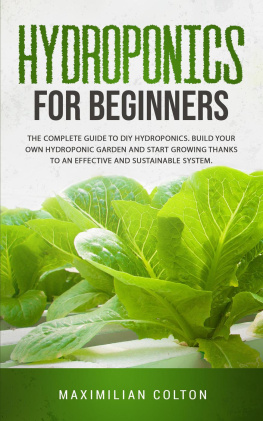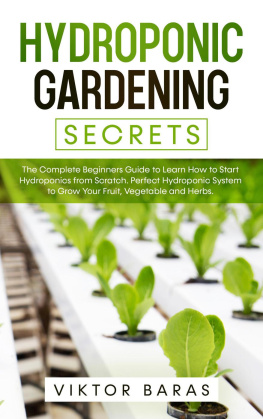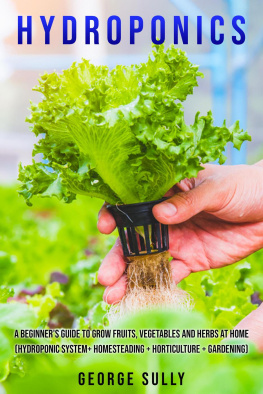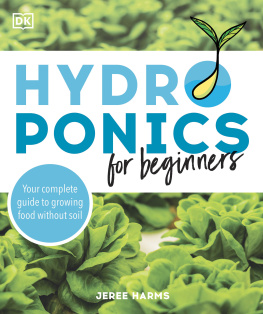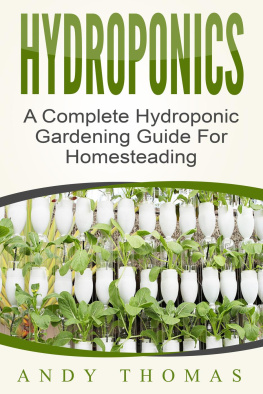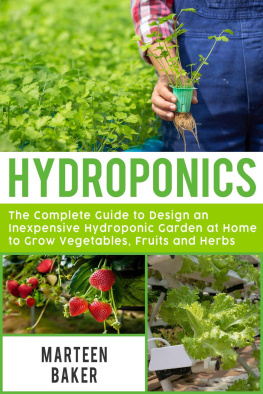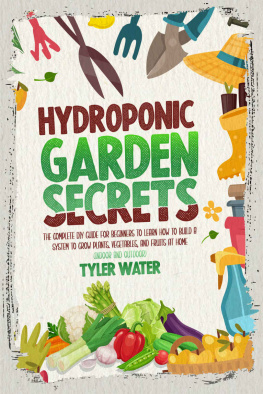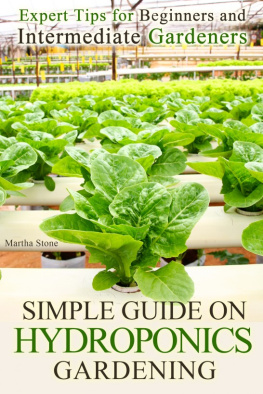Hydroponics for Beginners
Maximilian Colton
Published by Maximilian Colton, 2021.
While every precaution has been taken in the preparation of this book, the publisher assumes no responsibility for errors or omissions, or for damages resulting from the use of the information contained herein.
HYDROPONICS FOR BEGINNERS
First edition. March 6, 2021.
Copyright 2021 Maximilian Colton.
Written by Maximilian Colton.
10 9 8 7 6 5 4 3 2 1
TABLE OF CONTENTS
C ongratulations on purchasing Hydroponics for Beginners, and thank you for doing so.
Hydroponic gardening is becoming incredibly popular in recent days. Though it has been around in some ways for centuries, it is only with modern technology that it is becoming large enough to be of interest to general agriculture. More and more farmers are taking the plunge and making the switch over to a hydroponic gardening system for varying reasons. Thanks to its sustainability, it is far more effective at ensuring that everyone can get what they need for a longer period of time without causing damage to the environment.
Now, you may be wondering: Who needs a hydroponic garden? The answer is that nearly anyone could benefit from these gardens. If you have ever wanted to garden but lived in an apartment or lived in an area that is not hospitable to the plants that you want to grow, it could be that hydroponic gardening is for you. If you have ever wanted to garden but were worried about the cost of constant watering, or the waste of water when you could otherwise use it elsewhere, hydroponic gardening is for you. If you want to grow something and its the middle of winter, and there is a foot of snow outside, this method is for you.
Hydroponic gardening is incredibly versatile. It allows for the development of a garden in any climate and in any space. It is the use of gardening without soil, and you may be thinking that without soil, a garden cannot grow. However, as you will see shortly, the soil is not a part of the equation when it comes to plants growing. If anything, it is a conduit rather than a requirement in itself. If you can substitute the soil for another method to provide the nutrients for the plants, you can make them grow in just about anything that will not damage the roots. There are even methods that you can use to grow plants with the roots suspended in the air without being buried in anything!
When you read this book, you are being introduced to everything that you would possibly need to know about hydroponic gardening to get started for you. You will learn how you can grow your own plants. You can learn how you can begin to garden at homeon any budget. You can grow a plant in a system put together with supplies that you probably already have sitting around at home, or you can make use of several other methods as well. However, by reading this book, you will get everything that you need to know in one place.
From being able to identify what it means to grow something hydroponically to taking a look at everything that you will need to have on hand, you will get all necessary startup information for you. Then, you will learn how to build several low-cost options that are reasonable options for most gardeners. You will see how you can make use of just about any situation and just about any amount of space. You will then be guided through the gardening informationyou will learn about which plants will work best for beginners, how to nourish your plants, and how to ensure that you are providing them with the lighting that they will need to grow. Finally, you will learn everything that you will need to know about maintaining your system. From preventing pests to troubleshooting, you will see precisely what needs to happen to keep your garden functioning well.
There are plenty of books on this subject on the market, thanks again for choosing this one! Every effort was made to ensure it is full of as much useful information as possible; please enjoy!
What Is Hydroponics?
H ydroponic gardening is nothing new to history. It has been documented in the Hanging gardens of Babylon. It has been recorded as happening in both Mexico and in China in ancient days. It is no surprise that plants require sunlight or water to grow, but did you know that soil is not a required part of the equation to ensure that plants can grow? Study after study after study on plants, in trying to decide how they grow and what roles water and soil play, have been found to be required to have access to water, air, and light. However, the soil was not necessary. The soil, however, did provide something that the plants could make good use ofnutrients that would not be acquired otherwise.
While plants do make their own sustenance, that is more in the form of being able to make their own energy. Unlike humans or animals, which must eat to get energy, plants can make their own. However, like all living creatures, they still have some requirements that they cannot make themselves. Plants cannot get their own nutrientsthey need them to be provided in some way. For most plants, this happens in the soil. They require the soil to nourish them, providing necessities such as nitrogen, potassium, and phosphorus. However, some plants grow just fine in the water, and this is the basis for hydroponic gardening.
Within this chapter, we are going to explore exactly thatwe are going to take a nice, close look at hydroponic gardening and everything that it has to offer, as well as the requirements for what it is. Then, we will be taking a closer look at the benefits that growing your plants hydroponically will have, both in terms of your plant being able to grow more efficiently as well as in terms of sustainable agriculture. Finally, we will compare hydroponic gardening to traditional gardening so you can begin to make a decision on which is right for you sooner rather than later.
H ydroponics come from the root words hydro, meaning water, and ponics, meaning labor or working. It is, literally translated, water labor or water workit is the ability to grow plants in water. If you can make use of this concept, you are going to be growing your plants without them requiring soil. Now, keep in mind that that does not mean that you will not be growing without a growing mediumthough in some instances, you will not be. There will be something around your roots, whether it is water, air, or even rocks and wood chips. However, whatever it is, it will not be soil.

